PUBLICATIONS HIGHLIGHTS
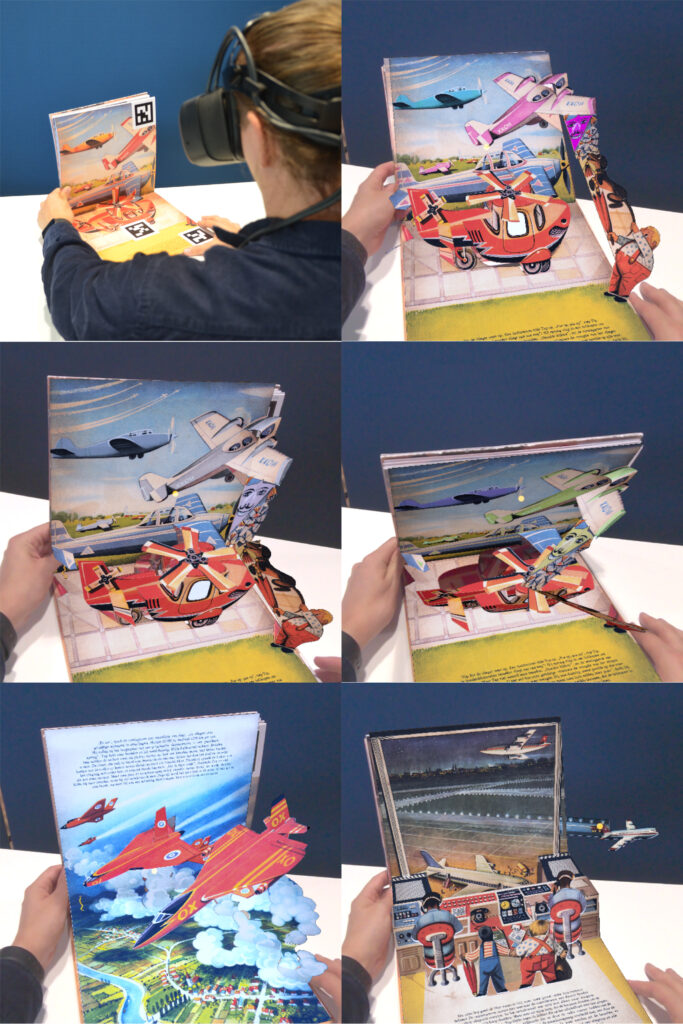
Willemijn Elkhuizen, Jeff Love, Stefano Parisi, Elvin Karana
Abstract: Direct interaction with cultural heritage (CH) artefacts is frequently unavailable to visitors, offering an opportunity for HCI designers to explore integrating material aspects into digitally-mediated encounters with CH artefacts. We argue that a thorough understanding of the material experiences of CH artefacts can open a novel design space, enabling engaging and meaningful interactions with digital representations. Capitalising on this potential, we present a user study where we systematically explore the material experiences of historic pop-up and movable books. Our analysis identifies five key material qualities to inspire augmentation: fold-ability, slideability, tear-ability, age-ability, and print-ability. Highlighting how these material qualities can inspire novel interactions with their digital representations, we present two extended-reality (XR) prototypes of a CH book. With our work, we present HCI designers with a novel approach on designing CH experiences, firmly rooted in materiality, challenging the prevalent paradigms of ‘technology driven’ or ‘as-realistic-as-possible’ sensory experiences often found in CH-HCI.
CHI ’24, May 11–16, 2024, Honolulu, HI, USA. (Accepted)
LIVING WITH CYANOBACTERIA: EXPLORING MATERIALITY IN CARING FOR MICROBES IN EVERYDAY LIFE.
Jiwei Zhou, Zjenja Doubrovski, Elisa Giaccardi, Elvin Karana
Abstract: Materiality of artefacts holds the potential to intricately and dynamically shape our daily practices. We posit this capacity can be harnessed in fostering creative unfolding of everyday care practices towards living artefacts. To explore this premise, we designed a cyanobacterial living artefact with air purifying capacity, and invited eight participants to live with and care for it for two weeks. The artefact can be situated in diverse locations within domestic spaces, wherever the participant would consider air purification necessary and certain lighting conditions beneficial for the artefact’s vitality. This versatility is supported by the artefact’s colour-changing, pliable, adhesive, and suspendable nature. We analysed visual documentations and semi-structured interviews of participants’ experiences of the artefact. Our findings suggest distinct roles of materiality for care regarding labour, knowledge, and exploration. We further highlight the intricate design space encompassing openness, temporalities and semantic fitness towards nurturing mutualistic care in human-microbe interactions.
CHI ’24, May 11–16, 2024, Honolulu, HI, USA. (Accepted)
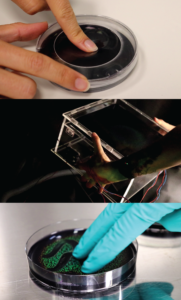
Clarice Risseeuw, Holly McQuillan, Joana Martins, Elvin Karana
Abstract: HCI designers increasingly engage in the integration of microbes into artefacts, leveraging their distinct biological affordances for novel interactions. While in many explorations the interaction between humans and microbes is mediated, scholars also highlight the potential of direct interactions, such as visualising mechanical distortions or fostering a sense of relationality with nonhumans through eliciting intimate encounters. Seizing upon this potential, our study delves into the realm of direct interactions involving Flavobacteria, recently introduced as a colour-changing interactive medium in HCI. We present a design space for direct interactions where humans can (re)activate, (re)direct, and (re)arrange Flavobacteria’s colourations, thereby fostering a personal and dynamic interplay between humans and microbes. With our work, we aspire to provide pathways and ignite inspiration among HCI designers to create living artefacts that cultivate active engagement and heightened attentiveness towards microbial worlds and beyond.
CHI ’24, May 11–16, 2024, Honolulu, HI, USA. (Accepted)
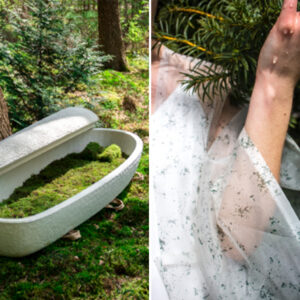
LIVING ARTEFACTS FOR REGENERATIVE ECOLOGIES.
Elvin Karana, Holly McQuillan, Valentina Rognoli, Elisa Giaccardi
Abstract: Introduced in 2020, the concept of living artefacts encompasses biodesign outcomes that uphold the livingness of organisms such as fungi, algae, bacteria, and plants, to enable the emergence of novel functions, interactions and expressions within everyday life. This paper situates living artefacts at the confluence of the sustainability discourse and more-thanhuman ontologies, illuminating the unprecedented opportunities that living artefacts present for regenerative ecologies. These ecologies are characterized by a fundamental inclination toward mutualism, creativity, and coevolution. In regenerative ecologies, the human-nature relationship transcends the binary distinction and it manifests as a single autopoietic system in which the constituent members collaboratively engage in the creation, transformation, and evolution of shared habitats. The paper outlines five pillars, supplemented by guiding questions and two illustrative cases, to aid designers in unlocking, articulating, and critically evaluating the potential of living artefacts for regenerative ecologies.
Journal of Research Directions: Biotechnology Design, 2023. (Accepted)
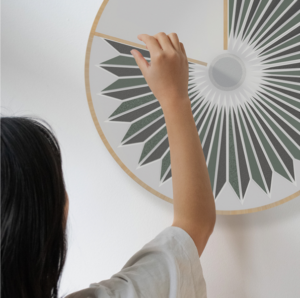
Jiwei Zhou, Raphael Kim, Zjenja Doubrovski, Joana Martins, Elisa Giaccardi, Elvin Karana
Abstract: Microbes offer designers opportunities to endow artefacts with environmental sensing and adapting abilities, and unique expres- sions. However, microbe-embedded artefacts present a challenge of temporal dissonance, reflected by a “time lag” typically experienced by humans in noticing the gradual and minute shifts in microbial metabolism. This could compromise fluency of interactions and may hinder timely noticing and attending to microbes in living artefacts. In addressing this challenge, we introduce Cyano-chromic Interface, in which photosynthetic activity of cyanobacteria (Syne- chocystis sp. PCC6803) is timely surfaced by an electrochromic (EC) material through its monochromatic display. Grounded through interface performance characterization and design primitives, we developed application concepts through which we instantiate how the interface can be tuned for diverse functional and experiential outcomes in living artefacts. We further discuss the potential of aligning human-microbe temporalities for enriched interactions and reciprocal relationships with microbes, and beyond.
DIS ‘23, July 10–14, 2023, Pittsburgh, PA, USA. ACM. ISBN 978-1-4503-9893-0/23/07. https://doi.org/10.1145/3563657.3596132
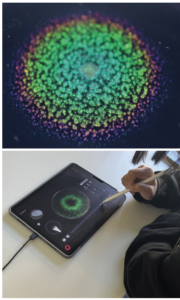
FLAVOMETRICS: TOWARDS A DIGITAL TOOL TO UNDERSTAND AND TUNE LIVING AESTHETICS OF FLAVOBACTERIA.
Clarice Risseeuw, Jose F. Martinez Castro, Pascal Barla, Elvin Karana
Abstract: Integrating microorganisms into artefacts is a growing area of interest for HCI designers. However, the time, resources, and knowledge required to understand complex microbial behaviour limits designers from creatively exploring temporal expressions in living artefacts, i.e., living aesthetics. Bridging biodesign and computer graphics, we developed FlavoMetrics, an interactive digital tool that supports biodesigners in exploring Flavobacteria’s living aesthetics. This open-source tool enables designers to virtually inoculate bacteria and manipulate stimuli to tune Flavobacteria’s living colour in a digital environment. Six biodesigners evaluated the tool and reflected on its implications for their practices, for example, in (1) understanding spatio-temporal qualities of microorganisms beyond 2D, (2) biodesign education, and (3) the experience prototyping of living artefacts. With FlavoMetrics, we hope to inspire novel HCI tools for accessible and time- and resource-efficient biodesign as well as for better alignment with divergent microbial temporalities in living with living artefacts.
DIS ‘23, July 10–14, 2023, Pittsburgh, PA, USA. ACM. ISBN 978-1-4503-9893-0/23/07. https://doi.org/10.1145/3563657.3596085
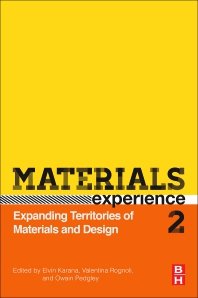
MATERIALS EXPERIENCE 2: EXPANDING TERRITORIES OF MATERIALS AND DESIGN.
Owain Pedgley, Valentina Rognoli, Elvin Karana (Eds.)
Abstract: Materials Experience 2: Expanding Territories of Materials and Design is the follow-up companion to Materials Experience published in 2014. Materials experience as a concept has evolved substantially and is now mobilized to incorporate new ways of thinking and designing. Through all-new peer-reviewed chapters and project write-ups, the book presents critical perspectives on new and emerging relationships between designers, materials, and artifacts. Subtitled Expanding Territories of Materials and Design, the book examines in depth the increased prevalence of material-driven design practices, as well as the changing role of materials themselves, toward active and influential agents within and outside design processes. The book is essential reading for anyone involved in materials and design, containing 11 authoritative chapters and 18 illustrated accounts of contemporary research projects and practices.
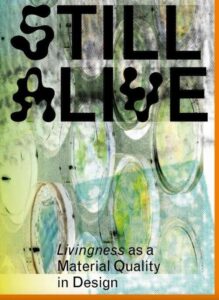
STILL ALIVE: LIVINGNESS AS A MATERIAL QUALITY IN DESIGN.
Elvin Karana
Abstract: STILL ALIVE presents the year-long journey of researchers from Material Incubator (Avans University of Applied Sciences, Delft University of Technology, Willem de Kooning Academy), shedding light on the practical and social aspects of designing and living with living artefacts.
Breda, Avans University of Applied Sciences, 2020. Available online.
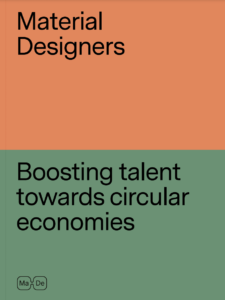
MATERIAL DESIGNERS: BOOSTING TALENT TOWARDS CIRCULAR ECONOMIES.
Laura Clèrries, Valentina Rognoli, Seetal Solanki, Pere Llorach (Eds.)
Abstract: MaDe Book provides a better understanding on how materials design can contribute to attain a more circular economy. It contains a compilation of expert articles and short interviews, a glossary of concepts, original resources, detailed finalists and winners’ projects and the full directory of material designers.
2021. Available online.
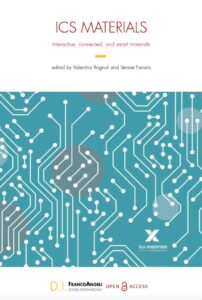
ICS MATERIALS: INTERACTIVE, CONNECTED, AND SMART MATERIALS
Valentina Rognoli, Venere Ferraro (Eds.)
Abstract: This present book covers a series of outstanding reputation researchers’ contributions on the topic of ICS Materials: a new class of emerging materials with properties and qualities concerning interactivity, connectivity and intelligence. In the general framework of ICS Materials’ domain, each chapter deals with a specific aspect following the characteristic perspective of each researcher. As result, methods, tools, guidelines emerged that are relevant and applicable to several contexts such as product, interaction design, materials science and many more.
Franco Angeli, Design International, 2020. Available online.

Valentina Rognoli, Massimo Bianchini, Stefano Maffei, Elvin Karana
Abstract: The democratization of personal fabrication technologies in parallel to the rising desire of individuals for personalizing their products offers great opportunities to experiment with advanced, distributed and shared production processes as well as design new materials. In this article, we introduce the notion of Do-It-Yourself (DIY) Materials, which are created through individual or collective self-production practices, often by techniques and processes of the designer’s own invention. They can be totally new materials, modified, or further developed versions of existing materials. In order to provide an operational vocabulary to discuss DIY materials, we have collected 27 DIY material cases developed in the last five years. We group the collected cases under two main categories: (1) DIY new materials: which focus on creative material ingredients (e.g. a material made of dried, blended waste citrus peel combined with natural binders); and (2) DIY new identities for conventional materials: which focus on new production techniques, giving new expressions to existing materials (i.e. they do not necessarily contain new ingredients, such as 3D printed metal). Grounded on the commonalities of collected cases, we discuss the design opportunities, including new aesthetic impressions offered through DIY material design practices.
Journal Article. Materials & Design, 2015. Available online.
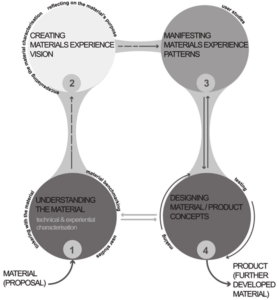
MATERIAL DRIVEN DESIGN (MDD): A METHOD TO DESIGN FOR MATERIAL EXPERIENCES.
Elvin Karana, Bahar Barati, Valentina Rognoli, Anouk Zeeuw van der Laan
Abstract: Materials research constantly offers novel materials as better alternatives to convention. Functional aptness is taken for granted at the first commercial launch of a new material. Nevertheless, this alone may not be enough for its commercial success and widespread use. The ‘material’ should also elicit meaningful user experiences in and beyond its utilitarian assessment. This requires qualifying the material not only for what it is, but also for what it does, what it expresses to us, what it elicits from us, and what it makes us do. In search of a proper application through such an understanding, material scientists and industries have reached out to designers to guide the development of materials by experiential goals. However, how to design for experiences with and for a material at hand has been poorly addressed to date. In this article, we propose a method, Material Driven Design (MDD), to facilitate designing for material experiences. After explaining the theoretical foundation of the method, an illustrative case is presented—where ‘coffee waste’ is the subject of a design effort to conceive a new product concept. Finally, possible research directions are addressed to bring new insights to the effective application of the MDD method to diverse projects.
Journal Article. International Journal of Design, 2015. Available online.
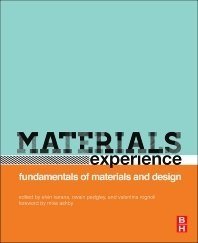
MATERIALS EXPERIENCE: FUNDAMENTALS OF MATERIALS AND DESIGN.
Elvin Karana, Owain Pedgley, Valentina Rognoli (Eds.)
Abstract: There currently exists an abundance of materials selection advice for designers suited to solving technical product requirements. In contrast, a stark gap can be found in current literature that articulates the very real personal, social, cultural and economic connections between materials and the design of the material world. In Materials Experience: fundamentals of materials and design, thirty-four of the leading academicians and experts, alongside 8 professional designers, have come together for the first time to offer their expertise and insights on a number of topics common to materials and product design. The result is a very readable and varied panorama on the world of materials and product design as it currently stands.
ALL PUBLICATIONS
2023
1.Karana, Elvin; McQuillan, Holly; Rognoli, Valentina; Giaccardi, Elisa
Living Artefacts for Regenerative Ecologies Journal Article
In: Journal of Research Directions: Biotechnology Design, 2023.
@article{nokey,
title = { Living Artefacts for Regenerative Ecologies},
author = {Elvin Karana and Holly McQuillan and Valentina Rognoli and Elisa Giaccardi},
year = {2023},
date = {2023-09-13},
urldate = {2023-09-13},
journal = {Journal of Research Directions: Biotechnology Design},
keywords = {},
pubstate = {published},
tppubtype = {article}
}
2.McQuillan, Holly; Karana, Elvin
Conformal, Seamless, Sustainable: Multimorphic Textile-Forms as a Material-Driven Design Approach for HCI Inproceedings
In: Proceedings of the 2023 CHI Conference on Human Factors in Computing Systems, Association for Computing Machinery, Hamburg, Germany, 2023, ISBN: 9781450394215.
@inproceedings{10.1145/3544548.3581156,
title = {Conformal, Seamless, Sustainable: Multimorphic Textile-Forms as a Material-Driven Design Approach for HCI},
author = {Holly McQuillan and Elvin Karana},
url = {https://doi.org/10.1145/3544548.3581156},
doi = {10.1145/3544548.3581156},
isbn = {9781450394215},
year = {2023},
date = {2023-01-01},
booktitle = {Proceedings of the 2023 CHI Conference on Human Factors in Computing Systems},
publisher = {Association for Computing Machinery},
address = {Hamburg, Germany},
series = {CHI '23},
abstract = {Technology embeddedness in HCI textiles has great potential for enabling novel interactions and enriched experiences, but unless carefully designed, could inadvertently worsen HCI’s sustainability problem. In an attempt to bridge sustainable debates and practical material-driven scholarship in HCI, we propose Multimorphic Textile-forms (MMTF), as a design approach developed through a lens of multiplicity and extended life cycles, that facilitate change in both design/production and use-time via the simultaneous thinking of the qualities and behaviour of material and form. We provide a number of cases, textile-form methods and vocabulary to enable exploration in this emerging design space. MMTF grants insights into textiles as complex material systems whose behaviour can be tuned across material, interaction and ecological scales for conformal, seamless, and sustainable outcomes.},
keywords = {},
pubstate = {published},
tppubtype = {inproceedings}
}
Technology embeddedness in HCI textiles has great potential for enabling novel interactions and enriched experiences, but unless carefully designed, could inadvertently worsen HCI’s sustainability problem. In an attempt to bridge sustainable debates and practical material-driven scholarship in HCI, we propose Multimorphic Textile-forms (MMTF), as a design approach developed through a lens of multiplicity and extended life cycles, that facilitate change in both design/production and use-time via the simultaneous thinking of the qualities and behaviour of material and form. We provide a number of cases, textile-form methods and vocabulary to enable exploration in this emerging design space. MMTF grants insights into textiles as complex material systems whose behaviour can be tuned across material, interaction and ecological scales for conformal, seamless, and sustainable outcomes.3.Kim, Raphael; Risseeuw, Clarice; Groutars, Eduard Georges; Karana, Elvin
Surfacing Livingness in Microbial Displays: A Design Taxonomy for HCI Inproceedings
In: Proceedings of the 2023 CHI Conference on Human Factors in Computing Systems, Association for Computing Machinery, Hamburg, Germany, 2023, ISBN: 9781450394215.
@inproceedings{10.1145/3544548.3581417,
title = {Surfacing Livingness in Microbial Displays: A Design Taxonomy for HCI},
author = {Raphael Kim and Clarice Risseeuw and Eduard Georges Groutars and Elvin Karana},
url = {https://doi.org/10.1145/3544548.3581417},
doi = {10.1145/3544548.3581417},
isbn = {9781450394215},
year = {2023},
date = {2023-01-01},
booktitle = {Proceedings of the 2023 CHI Conference on Human Factors in Computing Systems},
publisher = {Association for Computing Machinery},
address = {Hamburg, Germany},
series = {CHI '23},
abstract = {In recent years, there has been a notable proliferation and diversification of works in HCI, that integrate living microorganisms; an imperative lifeform dominating ecosystems of our planet. Yet despite the growing interest, there is a lack of structured lenses with which designers can strategize their processes of surfacing livingness; a material quality inherent in living artefacts with a potential to enrich user experiences and to initiate mutualistic care between humans and microorganisms. Through a systematic artefacts review and a case study on Flavobacteria, we have developed and instantiated a Taxonomy of Surfacing Livingness in Microbial Displays, consisting of six microbe-sensitive, tuneable mechanisms for human noticing of microorganisms: 1) Canvassing, 2) Marking, 3) Magnifying, 4) Translating, 5) Nudging, and 6) Molecular Programming. The taxonomy invites diverse and adaptable ways of generating and crafting microbial displays; towards overcoming microbe-specific surfacing constraints, integrating diverse stakeholders’ values, and enabling nuanced address of microbial welfare.},
keywords = {},
pubstate = {published},
tppubtype = {inproceedings}
}
In recent years, there has been a notable proliferation and diversification of works in HCI, that integrate living microorganisms; an imperative lifeform dominating ecosystems of our planet. Yet despite the growing interest, there is a lack of structured lenses with which designers can strategize their processes of surfacing livingness; a material quality inherent in living artefacts with a potential to enrich user experiences and to initiate mutualistic care between humans and microorganisms. Through a systematic artefacts review and a case study on Flavobacteria, we have developed and instantiated a Taxonomy of Surfacing Livingness in Microbial Displays, consisting of six microbe-sensitive, tuneable mechanisms for human noticing of microorganisms: 1) Canvassing, 2) Marking, 3) Magnifying, 4) Translating, 5) Nudging, and 6) Molecular Programming. The taxonomy invites diverse and adaptable ways of generating and crafting microbial displays; towards overcoming microbe-specific surfacing constraints, integrating diverse stakeholders’ values, and enabling nuanced address of microbial welfare.4.Carrete, Israel A.; Ghodrat, Sepideh; Scherer, Diana; Karana, Elvin
Understanding the effects of root structure on the mechanical behaviour of engineered plant root materials Journal Article
In: Materials & Design, vol. 225, pp. 111521, 2023, ISSN: 0264-1275.
@article{CARRETE2023111521,
title = {Understanding the effects of root structure on the mechanical behaviour of engineered plant root materials},
author = {Israel A. Carrete and Sepideh Ghodrat and Diana Scherer and Elvin Karana},
url = {https://www.sciencedirect.com/science/article/pii/S0264127522011443},
doi = {https://doi.org/10.1016/j.matdes.2022.111521},
issn = {0264-1275},
year = {2023},
date = {2023-01-01},
journal = {Materials & Design},
volume = {225},
pages = {111521},
abstract = {Plant root growth can be altered by introducing obstacles in the path of growth. This principle is used in design to produce planar grid structures composed of interweaving roots. The Engineered Plant Root Materials (EPRMs) grown with this method have the potential to serve as environmentally sensitive alternatives for conventional materials, but their applications are delimited by their material properties. To bridge the gap in the wider application of these materials, the role of plant root structure and an agar-agar matrix are explored in relation to the mechanical properties of the EPRMs. Tensile tests were performed on five root configurations, ranging from single roots to grids of varying sizes. Heterogeneities in each configuration suggest poor load distribution throughout the structure. Agar-agar was introduced as a biopolymer matrix to improve load distribution and tensile properties. Digital microscopy at the intersection of grid cells suggests a correlation between cell size, root tip density, and material strength. The largest cell size (2 cm) had the highest root tip density and yield strength (0.568 ± 0.181 roots/mm2 and 0.234 ± 0.018 MPa, respectively), whereas the structure with the least root tips (1 cm) was 31 % weaker.},
keywords = {},
pubstate = {published},
tppubtype = {article}
}
Plant root growth can be altered by introducing obstacles in the path of growth. This principle is used in design to produce planar grid structures composed of interweaving roots. The Engineered Plant Root Materials (EPRMs) grown with this method have the potential to serve as environmentally sensitive alternatives for conventional materials, but their applications are delimited by their material properties. To bridge the gap in the wider application of these materials, the role of plant root structure and an agar-agar matrix are explored in relation to the mechanical properties of the EPRMs. Tensile tests were performed on five root configurations, ranging from single roots to grids of varying sizes. Heterogeneities in each configuration suggest poor load distribution throughout the structure. Agar-agar was introduced as a biopolymer matrix to improve load distribution and tensile properties. Digital microscopy at the intersection of grid cells suggests a correlation between cell size, root tip density, and material strength. The largest cell size (2 cm) had the highest root tip density and yield strength (0.568 ± 0.181 roots/mm2 and 0.234 ± 0.018 MPa, respectively), whereas the structure with the least root tips (1 cm) was 31 % weaker.5.Zhou, Jiwei; Kim, Raphael; Doubrovski, Zjenja; Martins, Joana; Giaccardi, Elisa; Karana, Elvin
Cyano-chromic Interface: Aligning Human-Microbe Temporalities Towards Noticing and Attending to Living Artefacts Inproceedings
In: 2023.
@inproceedings{Zhou2023CyanochromicIA,
title = {Cyano-chromic Interface: Aligning Human-Microbe Temporalities Towards Noticing and Attending to Living Artefacts},
author = {Jiwei Zhou and Raphael Kim and Zjenja Doubrovski and Joana Martins and Elisa Giaccardi and Elvin Karana},
url = {https://api.semanticscholar.org/CorpusID:259376302},
year = {2023},
date = {2023-01-01},
urldate = {2023-01-01},
journal = {Proceedings of the 2023 ACM Designing Interactive Systems Conference},
keywords = {},
pubstate = {published},
tppubtype = {inproceedings}
}
6.Risseeuw, Clarice; Castro, Jose Francisco Martinez; Barla, Pascal; Karana, Elvin
FlavoMetrics: Towards a Digital Tool to Understand and Tune Living Aesthetics of Flavobacteria Inproceedings
In: 2023.
@inproceedings{Risseeuw2023FlavoMetricsTA,
title = {FlavoMetrics: Towards a Digital Tool to Understand and Tune Living Aesthetics of Flavobacteria},
author = {Clarice Risseeuw and Jose Francisco Martinez Castro and Pascal Barla and Elvin Karana},
url = {https://api.semanticscholar.org/CorpusID:259376374},
year = {2023},
date = {2023-01-01},
urldate = {2023-01-01},
journal = {Proceedings of the 2023 ACM Designing Interactive Systems Conference},
keywords = {},
pubstate = {published},
tppubtype = {inproceedings}
}
7.Buso, Alice; McQuillan, Holly; Voorwinden, Milou; Karana, Elvin
Weaving Textile-form Interfaces: A Material-Driven Design Journey Inproceedings
In: 2023.
@inproceedings{Buso2023WeavingTI,
title = {Weaving Textile-form Interfaces: A Material-Driven Design Journey},
author = {Alice Buso and Holly McQuillan and Milou Voorwinden and Elvin Karana},
url = {https://api.semanticscholar.org/CorpusID:259376419},
year = {2023},
date = {2023-01-01},
urldate = {2023-01-01},
journal = {Proceedings of the 2023 ACM Designing Interactive Systems Conference},
keywords = {},
pubstate = {published},
tppubtype = {inproceedings}
}
2022
8.Rognoli, Valentina; Petreca, Bruna; Pollini, Barbara; Saito, Carmen
Materials biography as a tool for designers exploration of bio-based and bio-fabricated materials for the sustainable fashion industry. Journal Article
In: SUSTAINABILITY: SCIENCE, PRACTICE, & POLICY, 2022.
@article{nokey,
title = {Materials biography as a tool for designers exploration of bio-based and bio-fabricated materials for the sustainable fashion industry.},
author = {Valentina Rognoli and Bruna Petreca and Barbara Pollini and Carmen Saito},
year = {2022},
date = {2022-10-22},
urldate = {2022-10-22},
journal = {SUSTAINABILITY: SCIENCE, PRACTICE, & POLICY},
keywords = {},
pubstate = {published},
tppubtype = {article}
}
9.Rognoli, Valentina; Anselmi, Laura; Duarte-Poblete, Sofia-Soledad
Materiales alternativos emergentes. Un enfoque de diseño sostenible. [Alternative emerging materials. A focus on sustainable design} Journal Article
In: CUADERNOS DEL CENTRO DE ESTUDIOS EN DISEÑO Y COMUNICACIÓN. ENSAYOS, vol. 166, pp. 123-132, 2022.
@article{nokey,
title = {Materiales alternativos emergentes. Un enfoque de diseño sostenible. [Alternative emerging materials. A focus on sustainable design}},
author = {Valentina Rognoli and Laura Anselmi and Sofia-Soledad Duarte-Poblete},
year = {2022},
date = {2022-10-14},
urldate = {2022-10-14},
journal = {CUADERNOS DEL CENTRO DE ESTUDIOS EN DISEÑO Y COMUNICACIÓN. ENSAYOS},
volume = {166},
pages = {123-132},
keywords = {},
pubstate = {published},
tppubtype = {article}
}
10.Duarte-Poblete, Sofia-Soledad; Bolzan, Patrizia; Parisi, Stefano; Rognoli, Valentina
Crafting Materials During COVID-19: The Locked-Down Material Lab. Journal Article
In: DIID, vol. 77, pp. 140-150, 2022.
@article{nokey,
title = {Crafting Materials During COVID-19: The Locked-Down Material Lab.},
author = {Sofia-Soledad Duarte-Poblete and Patrizia Bolzan and Stefano Parisi and Valentina Rognoli},
url = {https://www.diid.it/diid/index.php/diid/issue/view/diid77/diid77},
year = {2022},
date = {2022-10-13},
urldate = {2022-10-13},
journal = {DIID},
volume = {77},
pages = {140-150},
keywords = {},
pubstate = {published},
tppubtype = {article}
}
11.Oliviera, Pedro; Rognoli, Valentina; Holzbach, Markus
Design for New Materials and New Manufacturing Technologies Book Chapter
In: Developments in Design Research and Practice. Senses 2019. Springer Series in Design and Innovation., vol. 17, pp. 61-66, Springer, 2022.
@inbook{nokey,
title = {Design for New Materials and New Manufacturing Technologies},
author = {Pedro Oliviera and Valentina Rognoli and Markus Holzbach},
year = {2022},
date = {2022-10-13},
urldate = {2022-10-13},
booktitle = {Developments in Design Research and Practice. Senses 2019. Springer Series in Design and Innovation.},
volume = {17},
pages = {61-66},
publisher = {Springer},
keywords = {},
pubstate = {published},
tppubtype = {inbook}
}
12.Jacob-Dazarola, Rubén; de-Francisco-Vela, Santiago; Rognoli, Valentina
Affective-Driven Design: Emotions, Moods and Experiences as Catalysts for Socially Meaningful Design. Journal Article
In: DISEÑA, 2022.
@article{nokey,
title = {Affective-Driven Design: Emotions, Moods and Experiences as Catalysts for Socially Meaningful Design.},
author = {Rubén Jacob-Dazarola and Santiago de-Francisco-Vela and Valentina Rognoli},
year = {2022},
date = {2022-10-07},
urldate = {2022-10-07},
journal = {DISEÑA},
keywords = {},
pubstate = {published},
tppubtype = {article}
}
13.Buso, Alice; McQuillan, Holly; Jansen, Kaspar; Karana, Elvin
The unfolding of textileness in animated textiles: An exploration of woven textile-forms Inproceedings
In: Proceedings of DRS, Design Research Society, 2022.
@inproceedings{Buso2022,
title = {The unfolding of textileness in animated textiles: An exploration of woven textile-forms},
author = {Alice Buso and Holly McQuillan and Kaspar Jansen and Elvin Karana},
url = {https://doi.org/10.21606/drs.2022.612},
doi = {10.21606/drs.2022.612},
year = {2022},
date = {2022-06-01},
urldate = {2022-06-01},
booktitle = {Proceedings of DRS},
publisher = {Design Research Society},
keywords = {},
pubstate = {published},
tppubtype = {inproceedings}
}
14.Groutars, Eduard Georges; Risseeuw, Carmen Clarice; Ingham, Colin; Hamidjaja, Raditijo; Elkhuizen, Willemijn S.; Pont, Sylvia C.; Karana, Elvin
Flavorium: An Exploration of Flavobacteria's Living Aesthetics for Living Color Interfaces Inproceedings
In: Lampe, Cliff; Barbosa, Simone (Ed.): CHI 2022 - Proceedings of the 2022 CHI Conference on Human Factors in Computing Systems, Ässociation for Computing Machinery (ACM)", Ünited States", 2022, (2022 CHI Conference on Human Factors in Computing Systems, CHI 2022 ; Conference date: 30-04-2022 Through 05-05-2022).
@inproceedings{40ab4817c38547718acdebd5300b5f31,
title = {Flavorium: An Exploration of Flavobacteria's Living Aesthetics for Living Color Interfaces},
author = {Eduard Georges Groutars and Carmen Clarice Risseeuw and Colin Ingham and Raditijo Hamidjaja and Willemijn S. Elkhuizen and Sylvia C. Pont and Elvin Karana},
editor = {Cliff Lampe and Simone Barbosa},
doi = {10.1145/3491102.3517713},
year = {2022},
date = {2022-01-01},
booktitle = {CHI 2022 - Proceedings of the 2022 CHI Conference on Human Factors in Computing Systems},
publisher = {Ässociation for Computing Machinery (ACM)"},
address = {Ünited States"},
series = {Conference on Human Factors in Computing Systems - Proceedings},
abstract = {Flavobacteria, which can be found in marine environments, are able to grow in highly organized colonies producing vivid iridescent colorations. While much is known about the biology of these organisms, their design potential as responsive media in user interfaces has not been explored. Our paper aims at bridging this gap by providing insights into the type, degree, and duration of change in Flavobacteria's expression, i.e., their living aesthetics. We present a tool to capture and characterize these changes concerning form, texture and iridescent color. To support the long-term study of their living aesthetics, we designed Flavorium. This bio-digital artifact provides the necessary habitat conditions for Flavobacteria to thrive for a month. Granting insights into the responsive behavior of this organism, this work presents a design space, vocabulary, and application concepts to inspire HCI and design scholars to investigate the complex temporal qualities of living media for future user interfaces.},
note = {2022 CHI Conference on Human Factors in Computing Systems, CHI 2022 ; Conference date: 30-04-2022 Through 05-05-2022},
keywords = {},
pubstate = {published},
tppubtype = {inproceedings}
}
Flavobacteria, which can be found in marine environments, are able to grow in highly organized colonies producing vivid iridescent colorations. While much is known about the biology of these organisms, their design potential as responsive media in user interfaces has not been explored. Our paper aims at bridging this gap by providing insights into the type, degree, and duration of change in Flavobacteria's expression, i.e., their living aesthetics. We present a tool to capture and characterize these changes concerning form, texture and iridescent color. To support the long-term study of their living aesthetics, we designed Flavorium. This bio-digital artifact provides the necessary habitat conditions for Flavobacteria to thrive for a month. Granting insights into the responsive behavior of this organism, this work presents a design space, vocabulary, and application concepts to inspire HCI and design scholars to investigate the complex temporal qualities of living media for future user interfaces.15.Zhou, Jiwei; Barati, Bahareh; Giaccardi, Elisa; Karana, Elvin
Habitabilities of Living Artefacts: A Taxonomy of Digital Tools for Biodesign Journal Article
In: International Journal of Design, vol. 16, no. 2, pp. 57–73, 2022, ISSN: 1991-3761.
@article{f7b9783d4c154180b6260eb3acc8ab66,
title = {Habitabilities of Living Artefacts: A Taxonomy of Digital Tools for Biodesign},
author = {Jiwei Zhou and Bahareh Barati and Elisa Giaccardi and Elvin Karana},
doi = {10.57698/v16i2.05},
issn = {1991-3761},
year = {2022},
date = {2022-01-01},
journal = {International Journal of Design},
volume = {16},
number = {2},
pages = {57--73},
publisher = {National Taiwan University of Science and Technology},
abstract = {This paper offers a taxonomy of digital tools for crafting habitabilities in biodesign practices. Over the past decade, interest has grown among design and Human-Computer Interaction (HCI) scholars to explore the potentials of living organisms for novel responsive behavior and interaction possibilities. Yet, to date, it remains unexplored how digital technologies can support the design of living artefacts, that is, artefacts in which the organism is alive at the time of use. Our taxonomy bridges this gap by examining and reinterpreting the roles existing digital tools can play in the exploration of the abilities of things to provide a habitat for living artefacts both at design time and use time, i.e., crafting habitabilities in biodesign. The taxonomy is grounded in a systematic analysis of ten cases of living artefacts from art, design, and HCI, and it identifies three roles for digital tools: understanding, embodying, and perpetuating the habitat. Forwarding a relational perspective through the lens of habitability, this work promotes the mutual wellbeing of both humans and non-humans in biodesign.},
keywords = {},
pubstate = {published},
tppubtype = {article}
}
This paper offers a taxonomy of digital tools for crafting habitabilities in biodesign practices. Over the past decade, interest has grown among design and Human-Computer Interaction (HCI) scholars to explore the potentials of living organisms for novel responsive behavior and interaction possibilities. Yet, to date, it remains unexplored how digital technologies can support the design of living artefacts, that is, artefacts in which the organism is alive at the time of use. Our taxonomy bridges this gap by examining and reinterpreting the roles existing digital tools can play in the exploration of the abilities of things to provide a habitat for living artefacts both at design time and use time, i.e., crafting habitabilities in biodesign. The taxonomy is grounded in a systematic analysis of ten cases of living artefacts from art, design, and HCI, and it identifies three roles for digital tools: understanding, embodying, and perpetuating the habitat. Forwarding a relational perspective through the lens of habitability, this work promotes the mutual wellbeing of both humans and non-humans in biodesign.16.Castro, Jose Francisco Martinez; Buso, Alice; Wu, Jun; Karana, Elvin
TEX(alive): a toolkit to explore temporal expressions in shape-changing textile interfaces Inproceedings
In: DIS 2022 - Proceedings of the 2022 ACM Designing Interactive Systems Conference, pp. 1162–1176, Ässociation for Computing Machinery (ACM), Ünited States, 2022, (2022 ACM Designing Interactive Systems Conference: Digital Wellbeing, DIS 2022 ; Conference date: 13-06-2022 Through 17-06-2022).
@inproceedings{3d025d9a0aa249fe908199f889ac7a28,
title = {TEX(alive): a toolkit to explore temporal expressions in shape-changing textile interfaces},
author = {Jose Francisco Martinez Castro and Alice Buso and Jun Wu and Elvin Karana},
doi = {10.1145/3532106.3533515},
year = {2022},
date = {2022-01-01},
urldate = {2022-01-01},
booktitle = {DIS 2022 - Proceedings of the 2022 ACM Designing Interactive Systems Conference},
pages = {1162--1176},
publisher = {Ässociation for Computing Machinery (ACM)},
address = {Ünited States},
series = {DIS 2022 - Proceedings of the 2022 ACM Designing Interactive Systems Conference: Digital Wellbeing},
abstract = {Shape-changing textile interfaces have the potential to create unique functions, expressions, and interactions in everyday artifacts. However, the technical expertise required to fabricate and interact with these interfaces limits designers from rapidly iterating through diverse textile expressions. This pictorial presents TEX(alive), a low-cost and open-source physical-digital toolkit to facilitate the creation of temporal expressions in textile interfaces. TEX(alive) comprises pneumatic actuators that can be interactively configured across a 3d printed grid structure on the textile. Creative sessions with seven designers show that TEX(alive) supports the exploration of temporality in textile interfaces, opening up a design space for unforeseen future application scenarios and alive-like expressions in material-driven design. Finally, we suggest coupling TEX(alive) with a computational simulation tool to allow designers to predict spatial shape change when the textile interface increases in size or complexity.},
note = {2022 ACM Designing Interactive Systems Conference: Digital Wellbeing, DIS 2022 ; Conference date: 13-06-2022 Through 17-06-2022},
keywords = {},
pubstate = {published},
tppubtype = {inproceedings}
}
Shape-changing textile interfaces have the potential to create unique functions, expressions, and interactions in everyday artifacts. However, the technical expertise required to fabricate and interact with these interfaces limits designers from rapidly iterating through diverse textile expressions. This pictorial presents TEX(alive), a low-cost and open-source physical-digital toolkit to facilitate the creation of temporal expressions in textile interfaces. TEX(alive) comprises pneumatic actuators that can be interactively configured across a 3d printed grid structure on the textile. Creative sessions with seven designers show that TEX(alive) supports the exploration of temporality in textile interfaces, opening up a design space for unforeseen future application scenarios and alive-like expressions in material-driven design. Finally, we suggest coupling TEX(alive) with a computational simulation tool to allow designers to predict spatial shape change when the textile interface increases in size or complexity.17.Ng, Wasabii; Barati, Bahareh; Karana, Elvin
Healing with Fungi: Unique Aesthetic Expressions for Mycelium-Based Materials Through Patch and Mend Inproceedings
In: Bruyns, Gerhard; Wei, Huaxin (Ed.): [ ] With Design: Reinventing Design Modes, pp. 3253–3267, Springer Nature Singapore, Singapore, 2022, ISBN: 978-981-19-4472-7.
@inproceedings{10.1007/978-981-19-4472-7_210,
title = {Healing with Fungi: Unique Aesthetic Expressions for Mycelium-Based Materials Through Patch and Mend},
author = {Wasabii Ng and Bahareh Barati and Elvin Karana},
editor = {Gerhard Bruyns and Huaxin Wei},
isbn = {978-981-19-4472-7},
year = {2022},
date = {2022-01-01},
booktitle = {[ ] With Design: Reinventing Design Modes},
pages = {3253--3267},
publisher = {Springer Nature Singapore},
address = {Singapore},
abstract = {Fungi is a highly attractive organism for biodesign with the potential of converting agro-industrial waste into novel materials, suitable for diverse applications from acoustic panels to packaging, from textiles to building material. This paper presents an explorative study that taps into a relatively unexplored potential of fungi in biodesign, namely, ``to heal'' living and non-living mycelium-based materials. When still alive, the fungus can fill in the material substrate with a network of thread-like roots called mycelium. By revisiting the concept of the patch and mend, we can repair and reappropriate mycelium-based materials and extend their lifetime. By leveraging the livingness of fungi, our material-driven explorations demonstrate unique aesthetic expressions in the healed mycelium-based samples toward the revival of daily repair practices.},
keywords = {},
pubstate = {published},
tppubtype = {inproceedings}
}
Fungi is a highly attractive organism for biodesign with the potential of converting agro-industrial waste into novel materials, suitable for diverse applications from acoustic panels to packaging, from textiles to building material. This paper presents an explorative study that taps into a relatively unexplored potential of fungi in biodesign, namely, ``to heal'' living and non-living mycelium-based materials. When still alive, the fungus can fill in the material substrate with a network of thread-like roots called mycelium. By revisiting the concept of the patch and mend, we can repair and reappropriate mycelium-based materials and extend their lifetime. By leveraging the livingness of fungi, our material-driven explorations demonstrate unique aesthetic expressions in the healed mycelium-based samples toward the revival of daily repair practices.2021
18.Pollini, Barbara; Rognoli, Valentina
Early-stage material selection based on life cycle approach: tools, obstacles and opportunities for design. Journal Article
In: SUSTAINABLE PRODUCTION AND CONSUMPTION, 2021.
@article{nokey,
title = {Early-stage material selection based on life cycle approach: tools, obstacles and opportunities for design.},
author = {Barbara Pollini and Valentina Rognoli},
year = {2021},
date = {2021-10-22},
urldate = {2021-10-22},
journal = {SUSTAINABLE PRODUCTION AND CONSUMPTION},
keywords = {},
pubstate = {published},
tppubtype = {article}
}
19.Rognoli, Valentina; Parisi, Stefano
In: Rognoli, Valentina; Ferraro, Venere (Ed.): ICS Materials: interactive, connected, and smart materials, pp. 111-125, Design International series. Franco Angeli. , 2021.
@inbook{nokey,
title = {ICS Materiality: the phenomenon of interactive, connected and smart materials as enablers of new materials experiences. },
author = {Valentina Rognoli and Stefano Parisi},
editor = {Valentina Rognoli and Venere Ferraro},
url = {http://ojs.francoangeli.it/_omp/index.php/oa/catalog/book/641},
year = {2021},
date = {2021-10-21},
urldate = {2021-10-21},
booktitle = {ICS Materials: interactive, connected, and smart materials},
pages = {111-125},
publisher = {Design International series. Franco Angeli. },
keywords = {},
pubstate = {published},
tppubtype = {inbook}
}
20.Pollini, Barbara; Rognoli, Valentina
Enhancing living/non-living relationships through designed materials. Inproceedings
In: Proceedings of CEES 2021, International Conference Construction, Energy, Environment & Sustainability. Responsible Biotechnologies And Biodesign For The Built Environment., 2021, ISBN: 978-989-54499-1-0.
@inproceedings{nokey,
title = {Enhancing living/non-living relationships through designed materials.},
author = {Barbara Pollini and Valentina Rognoli},
isbn = {978-989-54499-1-0},
year = {2021},
date = {2021-10-21},
urldate = {2021-10-21},
booktitle = {Proceedings of CEES 2021, International Conference Construction, Energy, Environment & Sustainability. Responsible Biotechnologies And Biodesign For The Built Environment.},
keywords = {},
pubstate = {published},
tppubtype = {inproceedings}
}
21.Parisi, Stefano; Rognoli, Valentina
Design for ICS Materials: the development of tools and methods for the inspiration and ideation phases. Book Chapter
In: Rognoli, Valentina; Ferraro, Venere (Ed.): ICS Materials: interactive, connected, and smart materials, pp. 203-217, Design International series. Franco Angeli. , 2021.
@inbook{nokey,
title = {Design for ICS Materials: the development of tools and methods for the inspiration and ideation phases.},
author = {Stefano Parisi and Valentina Rognoli},
editor = {Valentina Rognoli and Venere Ferraro},
url = {http://ojs.francoangeli.it/_omp/index.php/oa/catalog/book/641},
year = {2021},
date = {2021-10-15},
urldate = {2021-10-15},
booktitle = {ICS Materials: interactive, connected, and smart materials},
pages = {203-217},
publisher = {Design International series. Franco Angeli. },
keywords = {},
pubstate = {published},
tppubtype = {inbook}
}
22.Rognoli, Valentina; Pollini, Barbara; Alessandrini, Luca
Design materials for the transition toward post-Anthropocene. Book Chapter
In: Camocini, Barbara; Vergani, Francesco (Ed.): FROM HUMAN-CENTERED TO MORE-THAN-HUMAN DESIGN. Exploring the transition., Franco Angeli International, 2021.
@inbook{nokey,
title = {Design materials for the transition toward post-Anthropocene.},
author = {Valentina Rognoli and Barbara Pollini and Luca Alessandrini},
editor = {Barbara Camocini and Francesco Vergani},
year = {2021},
date = {2021-10-15},
urldate = {2021-10-15},
booktitle = {FROM HUMAN-CENTERED TO MORE-THAN-HUMAN DESIGN. Exploring the transition.},
publisher = {Franco Angeli International},
keywords = {},
pubstate = {published},
tppubtype = {inbook}
}
23.Romani, Alessia; Rognoli, Valentina; Levi, Marinella
Design, Materials, and Extrusion-Based Additive Manufacturing in Circular Economy Contexts: From Waste to New Products. Journal Article
In: SUSTAINABILITY, 2021.
@article{nokey,
title = {Design, Materials, and Extrusion-Based Additive Manufacturing in Circular Economy Contexts: From Waste to New Products.},
author = {Alessia Romani and Valentina Rognoli and Marinella Levi},
year = {2021},
date = {2021-10-15},
urldate = {2021-10-15},
journal = {SUSTAINABILITY},
keywords = {},
pubstate = {published},
tppubtype = {article}
}
24.Rognoli, Valentina; Ferraro, Venere (Ed.)
ICS Materials: interactive, connected, and smart materials. Book
Design International series. Franco Angeli. , 2021.
@book{nokey,
title = {ICS Materials: interactive, connected, and smart materials.},
editor = {Valentina Rognoli and Venere Ferraro},
url = {http://ojs.francoangeli.it/_omp/index.php/oa/catalog/book/641},
year = {2021},
date = {2021-10-14},
urldate = {2021-10-14},
publisher = {Design International series. Franco Angeli. },
keywords = {},
pubstate = {published},
tppubtype = {book}
}
25.Rognoli, Valentina; Ayala-Garcia, Camilo; Pollini, Barbara
DIY Recipes: Ingredients, processes & materials qualities. Book Chapter
In: Clèries, Laura; Rognoli, Valentina; Solanki, Seetal; Llorach, Pere (Ed.): Materials Designers. Boosting talent towards circular economies, pp. 27-33, 2021, ISBN: 978-84-09-24438-6.
@inbook{nokey,
title = {DIY Recipes: Ingredients, processes & materials qualities.},
author = {Valentina Rognoli and Camilo Ayala-Garcia and Barbara Pollini},
editor = {Laura Clèries and Valentina Rognoli and Seetal Solanki and Pere Llorach},
isbn = {978-84-09-24438-6},
year = {2021},
date = {2021-10-14},
urldate = {2021-10-14},
booktitle = {Materials Designers. Boosting talent towards circular economies},
pages = {27-33},
keywords = {},
pubstate = {published},
tppubtype = {inbook}
}
26.Rognoli, Valentina; Ayala-Garcia, Valentina Rognoli and Camilo
Defining the DIY-Materials approach. Book Chapter
In: Pedgley, Owain; Rognoli, Valentina; Karana, Elvin (Ed.): Materials Experience 2: Expanding Territories of Materials and Design, Elsevier, 2021.
@inbook{nokey,
title = {Defining the DIY-Materials approach.},
author = {Valentina Rognoli and Valentina Rognoli and Camilo Ayala-Garcia},
editor = {Owain Pedgley and Valentina Rognoli and Elvin Karana},
year = {2021},
date = {2021-10-14},
urldate = {2021-10-14},
booktitle = {Materials Experience 2: Expanding Territories of Materials and Design},
publisher = {Elsevier},
keywords = {},
pubstate = {published},
tppubtype = {inbook}
}
27.Rognoli, Valentina; Parisi, Stefano
Material Tinkering and Creativity. Book Chapter
In: Cleries, Laura; Rognoli, Valentina; Solanki, Seetal; Llorach, Pere (Ed.): Material Designers. Boosting talent towards circular economies, pp. 20-25, 2021.
@inbook{nokey,
title = { Material Tinkering and Creativity.},
author = {Valentina Rognoli and Stefano Parisi},
editor = {Laura Cleries and Valentina Rognoli and Seetal Solanki and Pere Llorach},
url = {http://materialdesigners.org/wp-content/uploads/2021/03/MaDe-Book-1.pdf},
year = {2021},
date = {2021-10-08},
booktitle = {Material Designers. Boosting talent towards circular economies},
pages = {20-25},
keywords = {},
pubstate = {published},
tppubtype = {inbook}
}
28.Rognoli, Valentina; Zhou, Ziyu
Material Education: New Training, New Skills. Book Chapter
In: Cleries, Laura; Rognoli, Valentina; Solanki, Seetal; Llorach, Pere (Ed.): Materials Designers. Boosting talent towards circular economies, pp. 38-42, 2021, ISBN: 978-84-09-24438-6.
@inbook{nokey,
title = {Material Education: New Training, New Skills.},
author = {Valentina Rognoli and Ziyu Zhou},
editor = {Laura Cleries and Valentina Rognoli and Seetal Solanki and Pere Llorach},
isbn = {978-84-09-24438-6},
year = {2021},
date = {2021-10-08},
urldate = {2021-10-08},
booktitle = {Materials Designers. Boosting talent towards circular economies},
pages = {38-42},
keywords = {},
pubstate = {published},
tppubtype = {inbook}
}
29.Pedgley, Owain; Rognoli, Valentina; Karana, Elvin (Ed.)
Materials Experience: Expanding Territories of Materials and Design. Book
Elsevier, 2021, ISBN: 9780128192450.
@book{nokey,
title = {Materials Experience: Expanding Territories of Materials and Design.},
editor = {Owain Pedgley and Valentina Rognoli and Elvin Karana},
isbn = {9780128192450},
year = {2021},
date = {2021-10-07},
publisher = {Elsevier},
keywords = {},
pubstate = {published},
tppubtype = {book}
}
30.Clèries, Laura; Rognoli, Valentina
Materials Designers: A New Design Discipline. Book Chapter
In: Clèries, Laura; Rognoli, Valentina; Solanki, Seetal; Llorach, Pere (Ed.): Materials Designers. Boosting talent towards circular economies, pp. 43-47, 2021, ISBN: 978-84-09-24438-6.
@inbook{nokey,
title = {Materials Designers: A New Design Discipline.},
author = {Laura Clèries and Valentina Rognoli},
editor = {Laura Clèries and Valentina Rognoli and Seetal Solanki and Pere Llorach},
isbn = {978-84-09-24438-6},
year = {2021},
date = {2021-10-07},
urldate = {2021-10-07},
booktitle = {Materials Designers. Boosting talent towards circular economies},
pages = {43-47},
keywords = {},
pubstate = {published},
tppubtype = {inbook}
}
31.Parisi, Stefano; Holzbach, Markus; Rognoli, Valentina
Paving the way to post-digital smart materials. Experiments on human perception of a bio-inspired cellulose-based responsive interface. Inproceedings
In: Design Culture(s), Cumulus Roma 2021, 2021.
@inproceedings{nokey,
title = {Paving the way to post-digital smart materials. Experiments on human perception of a bio-inspired cellulose-based responsive interface.},
author = {Stefano Parisi and Markus Holzbach and Valentina Rognoli},
year = {2021},
date = {2021-07-14},
urldate = {2021-07-14},
booktitle = {Design Culture(s), Cumulus Roma 2021},
keywords = {},
pubstate = {published},
tppubtype = {inproceedings}
}
32.Clèries, Laura; Rognoli, Valentina; Solanki, Seetal; Llorach, Pere (Ed.)
Material Designers. Boosting talent towards circular economies. Book
2021, ISBN: 978-84-09-24439-3.
@book{nokey,
title = {Material Designers. Boosting talent towards circular economies.},
editor = {Laura Clèries and Valentina Rognoli and Seetal Solanki and Pere Llorach},
url = {http://materialdesigners.org/wp-content/uploads/2021/03/MaDe-Book-1.pdf},
isbn = {978-84-09-24439-3},
year = {2021},
date = {2021-01-10},
urldate = {2021-01-10},
keywords = {},
pubstate = {published},
tppubtype = {book}
}
33.Balasubramanian, Srikkanth; Yu, Kui; Meyer, Anne S.; Karana, Elvin; Aubin-Tam, Marie Eve
Bioprinting of Regenerative Photosynthetic Living Materials Journal Article
In: Ädvanced Functional Materials", vol. 31, no. 31, 2021, ISSN: 1616-301X.
@article{566db9bb05c34520b9ceb2227b7c8edb,
title = {Bioprinting of Regenerative Photosynthetic Living Materials},
author = {Srikkanth Balasubramanian and Kui Yu and Anne S. Meyer and Elvin Karana and Marie Eve Aubin-Tam},
doi = {10.1002/adfm.202011162},
issn = {1616-301X},
year = {2021},
date = {2021-01-01},
journal = {Ädvanced Functional Materials"},
volume = {31},
number = {31},
publisher = {Wiley-VCH Verlag},
abstract = {Living materials, which are fabricated by encapsulating living biological cells within a non-living matrix, have gained increasing attention in recent years. Their fabrication in spatially defined patterns that are mechanically robust is essential for their optimal functional performance but is difficult to achieve. Here, a bioprinting technique employing environmentally friendly chemistry to encapsulate microalgae within an alginate hydrogel matrix is reported. The bioprinted photosynthetic structures adopt pre-designed geometries at millimeter-scale resolution. A bacterial cellulose substrate confers exceptional advantages to this living material, including strength, toughness, flexibility, robustness, and retention of physical integrity against extreme physical distortions. The bioprinted materials possess sufficient mechanical strength to be self-standing, and can be detached and reattached onto different surfaces. Bioprinted materials can survive stably for a period of at least 3 days without nutrients, and their life can be further extended by transferring them to a fresh source of nutrients within this timeframe. These bioprints are regenerative, that is, they can be reused and expanded to print additional living materials. The fabrication of the bioprinted living materials can be readily up-scaled (up to ≥70 cm × 20 cm), highlighting their potential product applications including artificial leaves, photosynthetic bio-garments, and adhesive labels.},
keywords = {},
pubstate = {published},
tppubtype = {article}
}
Living materials, which are fabricated by encapsulating living biological cells within a non-living matrix, have gained increasing attention in recent years. Their fabrication in spatially defined patterns that are mechanically robust is essential for their optimal functional performance but is difficult to achieve. Here, a bioprinting technique employing environmentally friendly chemistry to encapsulate microalgae within an alginate hydrogel matrix is reported. The bioprinted photosynthetic structures adopt pre-designed geometries at millimeter-scale resolution. A bacterial cellulose substrate confers exceptional advantages to this living material, including strength, toughness, flexibility, robustness, and retention of physical integrity against extreme physical distortions. The bioprinted materials possess sufficient mechanical strength to be self-standing, and can be detached and reattached onto different surfaces. Bioprinted materials can survive stably for a period of at least 3 days without nutrients, and their life can be further extended by transferring them to a fresh source of nutrients within this timeframe. These bioprints are regenerative, that is, they can be reused and expanded to print additional living materials. The fabrication of the bioprinted living materials can be readily up-scaled (up to ≥70 cm × 20 cm), highlighting their potential product applications including artificial leaves, photosynthetic bio-garments, and adhesive labels.34.Zhou, Jiwei; Barati, Bahareh; Wu, Jun; Scherer, Diana; Karana, Elvin
Digital biofabrication to realize the potentials of plant roots for product design Journal Article
In: Bio-Design and Manufacturing, vol. 4, no. 1, pp. 111–122, 2021, ISSN: 2096-5524.
@article{f93be540800948e286b324ffc60a51c4,
title = {Digital biofabrication to realize the potentials of plant roots for product design},
author = {Jiwei Zhou and Bahareh Barati and Jun Wu and Diana Scherer and Elvin Karana},
doi = {10.1007/s42242-020-00088-2},
issn = {2096-5524},
year = {2021},
date = {2021-01-01},
journal = {Bio-Design and Manufacturing},
volume = {4},
number = {1},
pages = {111--122},
publisher = {Springer Science},
abstract = {Technological and economic opportunities, alongside the apparent ecological benefits, point to biodesign as a new industrial paradigm for the fabrication of products in the twenty-first century. The presented work studies plant roots as a biodesign material in the fabrication of self-supported 3D structures, where the biologically and digitally designed materials provide each other with structural stability. Taking a material-driven design approach, we present our systematic tinkering activities with plant roots to better understand and anticipate their responsive behaviour. These helped us to identify the key design parameters and advance the unique potential of plant roots to bind discrete porous structures. We illustrate this binding potential of plant roots with a hybrid 3D object, for which plant roots connect 600 computationally designed, optimized, and fabricated bioplastic beads into a low stool.},
keywords = {},
pubstate = {published},
tppubtype = {article}
}
Technological and economic opportunities, alongside the apparent ecological benefits, point to biodesign as a new industrial paradigm for the fabrication of products in the twenty-first century. The presented work studies plant roots as a biodesign material in the fabrication of self-supported 3D structures, where the biologically and digitally designed materials provide each other with structural stability. Taking a material-driven design approach, we present our systematic tinkering activities with plant roots to better understand and anticipate their responsive behaviour. These helped us to identify the key design parameters and advance the unique potential of plant roots to bind discrete porous structures. We illustrate this binding potential of plant roots with a hybrid 3D object, for which plant roots connect 600 computationally designed, optimized, and fabricated bioplastic beads into a low stool.35.Pedgley, Öwain; Rognoli, Valentina; Karana", Elvin
Expanding territories of materials and design Book Chapter
In: Materials Experience 2, pp. 1–12, Elsevier, Netherlands, 2021.
@inbook{07d9d1b838614bdca5c3440477812593,
title = {Expanding territories of materials and design},
author = {Öwain Pedgley and Valentina Rognoli and Elvin Karana"},
doi = {10.1016/B978-0-12-819244-3.00028-4},
year = {2021},
date = {2021-01-01},
booktitle = {Materials Experience 2},
pages = {1--12},
publisher = {Elsevier},
address = {Netherlands},
abstract = {Materials experience as a field has evolved substantially and is now mobilized to incorporate new ways of thinking and doing in design. The field has helped designers and researchers transform materials and design from a narrow-focused technically oriented selection process into a vibrant, investigative, and inspirational practice. This chapter introduces new and emerging relationships between designers, materials, and artifacts. To set a background, a concise account is provided of the lineage of materials experience and the materials experience framework. Three key themes defining the contemporary view of materials experience are explained. The first theme is the changing role of design and designers, where subjects including material-driven design practices, material tinkering, and DIY (do-it-yourself) materials, and the emergence of the material designer are introduced. The second theme is the changing role of materials themselves: materials are increasingly the centerpiece for design ideation and are becoming-especially through biodesign practices-active and influential agents within and outside design processes. The third theme is the role of materials experience in responding to sustainability goals, providing a foundation not only for inspiring environmentally sensitive material innovations but also for exploring people’s acceptance of such novel material proposals. Materials experience is projected to grow in importance: as a catalyst for new design practices (ways of thinking, ways of doing), as an influence on thoughtful choices of materials for design, and as a lens through which thoughtful decisions in new materials development may be taken.},
keywords = {},
pubstate = {published},
tppubtype = {inbook}
}
Materials experience as a field has evolved substantially and is now mobilized to incorporate new ways of thinking and doing in design. The field has helped designers and researchers transform materials and design from a narrow-focused technically oriented selection process into a vibrant, investigative, and inspirational practice. This chapter introduces new and emerging relationships between designers, materials, and artifacts. To set a background, a concise account is provided of the lineage of materials experience and the materials experience framework. Three key themes defining the contemporary view of materials experience are explained. The first theme is the changing role of design and designers, where subjects including material-driven design practices, material tinkering, and DIY (do-it-yourself) materials, and the emergence of the material designer are introduced. The second theme is the changing role of materials themselves: materials are increasingly the centerpiece for design ideation and are becoming-especially through biodesign practices-active and influential agents within and outside design processes. The third theme is the role of materials experience in responding to sustainability goals, providing a foundation not only for inspiring environmentally sensitive material innovations but also for exploring people’s acceptance of such novel material proposals. Materials experience is projected to grow in importance: as a catalyst for new design practices (ways of thinking, ways of doing), as an influence on thoughtful choices of materials for design, and as a lens through which thoughtful decisions in new materials development may be taken.36.Barati, Bahareh; Karana, Elvin; Pont, Sylvia; Dortmont, Tim Van
Living light interfaces - an exploration of bioluminescence aesthetics Inproceedings
In: DIS 2021 - Proceedings of the 2021 ACM Designing Interactive Systems Conference, pp. 1215–1229, Ässociation for Computing Machinery (ACM)", Ünited States", 2021, (2021 ACM Designing Interactive Systems Conference: Nowhere and Everywhere, DIS 2021 ; Conference date: 28-06-2021 Through 02-07-2021).
@inproceedings{6c688153b8324a3b87b759d5c9ea01d6,
title = {Living light interfaces - an exploration of bioluminescence aesthetics},
author = {Bahareh Barati and Elvin Karana and Sylvia Pont and Tim Van Dortmont},
doi = {10.1145/3461778.3462038},
year = {2021},
date = {2021-01-01},
booktitle = {DIS 2021 - Proceedings of the 2021 ACM Designing Interactive Systems Conference},
pages = {1215--1229},
publisher = {Ässociation for Computing Machinery (ACM)"},
address = {Ünited States"},
series = {DIS 2021 - Proceedings of the 2021 ACM Designing Interactive Systems Conference: Nowhere and Everywhere},
abstract = {This paper aims to provide first insights into flash characteristics of bioluminescent microalgae as a potential media for future living light interfaces. A growing number of HCI and interaction design researchers show interest in living material interfaces, which incorporate living organisms for novel responsive behaviour and interaction possibilities in digital and biological hybrids. While much is known about the science of these organisms, their gliving aesthetics', i.e., how humans experience the unique temporal changes in a living media, have hardly been explored. To bridge this gap in designing living light interfaces, this paper presents a study of bioluminescent flash characterisation. A DIY shaking device was designed to interact with the liquid living media, providing a range of stimuli including orbital rotation, pulsation and vibration. The living light aesthetics is presented with rich visuals illustrating the intensity variations over time, textural qualities and spatial distribution.},
note = {2021 ACM Designing Interactive Systems Conference: Nowhere and Everywhere, DIS 2021 ; Conference date: 28-06-2021 Through 02-07-2021},
keywords = {},
pubstate = {published},
tppubtype = {inproceedings}
}
This paper aims to provide first insights into flash characteristics of bioluminescent microalgae as a potential media for future living light interfaces. A growing number of HCI and interaction design researchers show interest in living material interfaces, which incorporate living organisms for novel responsive behaviour and interaction possibilities in digital and biological hybrids. While much is known about the science of these organisms, their gliving aesthetics', i.e., how humans experience the unique temporal changes in a living media, have hardly been explored. To bridge this gap in designing living light interfaces, this paper presents a study of bioluminescent flash characterisation. A DIY shaking device was designed to interact with the liquid living media, providing a range of stimuli including orbital rotation, pulsation and vibration. The living light aesthetics is presented with rich visuals illustrating the intensity variations over time, textural qualities and spatial distribution.37.D'Olivo, Patrizia; Karana, Elvin
Materials Framing: A Case Study of Biodesign Companies’ Web Communications Journal Article
In: She Ji: The Journal of Design, Economics, and Innovation, vol. 7, no. 3, pp. 403–434, 2021, ISSN: 2405-8726.
@article{4ac034860cd84279bbbee1e89d568bb9,
title = {Materials Framing: A Case Study of Biodesign Companies’ Web Communications},
author = {Patrizia D'Olivo and Elvin Karana},
doi = {10.1016/j.sheji.2021.03.002},
issn = {2405-8726},
year = {2021},
date = {2021-01-01},
urldate = {2021-01-01},
journal = {She Ji: The Journal of Design, Economics, and Innovation},
volume = {7},
number = {3},
pages = {403--434},
publisher = {Elsevier},
abstract = {Ädvances in biodesign offer opportunities for developing materials for everyday products from living organisms, such as fungi, algae, and bacteria. Gaining widespread acceptance of new materials from the general public can be a lengthy process, making biodesign a high-risk pursuit with potentially significant economic, ecological, and social impacts. In this article, we conceptualize the notion of materials framing—combining knowledge from materials science, product design, and innovation management to create a communications strategy that accelerates popular adoption of novel materials. Which of its qualities will help orient users’ understanding of the new material? What is the best way to present those qualities? An extensive analysis of nine biodesign companies’ text and visual web communications revealed three core materials framing categories: material origins, fabrication processes, and material outcomes. We argue that these three categories expand the audiences’ focus beyond mere outcomes to include an organism's design potential—a lens with which to gain a more comprehensive view of the possibilities the material from a living organism affords."},
keywords = {},
pubstate = {published},
tppubtype = {article}
}
Ädvances in biodesign offer opportunities for developing materials for everyday products from living organisms, such as fungi, algae, and bacteria. Gaining widespread acceptance of new materials from the general public can be a lengthy process, making biodesign a high-risk pursuit with potentially significant economic, ecological, and social impacts. In this article, we conceptualize the notion of materials framing—combining knowledge from materials science, product design, and innovation management to create a communications strategy that accelerates popular adoption of novel materials. Which of its qualities will help orient users’ understanding of the new material? What is the best way to present those qualities? An extensive analysis of nine biodesign companies’ text and visual web communications revealed three core materials framing categories: material origins, fabrication processes, and material outcomes. We argue that these three categories expand the audiences’ focus beyond mere outcomes to include an organism's design potential—a lens with which to gain a more comprehensive view of the possibilities the material from a living organism affords."2020
38.Rognoli, Valentina
Dynamism as an emerging materials experience for ICS Material. Book Chapter
In: Ferraro, Venere; Pasold, Anke (Ed.): Emerging Materials & Technologies. New approaches in Design Teaching Methods on four exemplified areas., Franco Angeli International, 2020.
@inbook{nokey,
title = {Dynamism as an emerging materials experience for ICS Material.},
author = {Valentina Rognoli},
editor = {Venere Ferraro and Anke Pasold},
year = {2020},
date = {2020-10-23},
urldate = {2020-10-23},
booktitle = {Emerging Materials & Technologies. New approaches in Design Teaching Methods on four exemplified areas.},
publisher = {Franco Angeli International},
keywords = {},
pubstate = {published},
tppubtype = {inbook}
}
39.Santulli, Carlo; Rognoli, Valentina
Material tinkering for design education on waste upcycling. Journal Article
In: DESIGN AND TECHNOLOGY EDUCATION, 2020.
@article{nokey,
title = {Material tinkering for design education on waste upcycling.},
author = {Carlo Santulli and Valentina Rognoli},
year = {2020},
date = {2020-10-23},
urldate = {2020-10-23},
journal = {DESIGN AND TECHNOLOGY EDUCATION},
keywords = {},
pubstate = {published},
tppubtype = {article}
}
40.Pollini, Barbara; Lavagna, Monica; Rognoli, Valentina
LCA-based material selection in the early stages of design: environmental benefits, tools, obstacles and opportunities. Inproceedings
In: Proceedings IX Conference of the Italian LCA Network Association, Cortina d'Ampezzo (BL)., 2020.
@inproceedings{nokey,
title = {LCA-based material selection in the early stages of design: environmental benefits, tools, obstacles and opportunities.},
author = {Barbara Pollini and Monica Lavagna and Valentina Rognoli},
year = {2020},
date = {2020-10-23},
urldate = {2020-10-23},
booktitle = {Proceedings IX Conference of the Italian LCA Network Association, Cortina d'Ampezzo (BL).},
keywords = {},
pubstate = {published},
tppubtype = {inproceedings}
}
41.Zhou, Ziyu; Rognoli, Valentina
Designing Materials and Material Designers: Research by DIY-Materials Research Group. Journal Article
In: ZHUANGSHI, 2020.
@article{nokey,
title = {Designing Materials and Material Designers: Research by DIY-Materials Research Group.},
author = {Ziyu Zhou and Valentina Rognoli},
year = {2020},
date = {2020-10-22},
urldate = {2020-10-22},
journal = {ZHUANGSHI},
keywords = {},
pubstate = {published},
tppubtype = {article}
}
42.Alarcón-Castro, Jimena; Rognoli, Valentina; Llorens-Vargas, Andrea
Diseñar para un escenario social incierto. El valor del enfoque materiales do-it-yourself y economía circular. [Designing for an uncertain social scenario. The value of do-it-yourself materials and circular economy]. Journal Article
In: Interciencia, vol. 45, núm. 6, pp. 279-285, 2020.
@article{nokey,
title = {Diseñar para un escenario social incierto. El valor del enfoque materiales do-it-yourself y economía circular. [Designing for an uncertain social scenario. The value of do-it-yourself materials and circular economy].},
author = {Jimena Alarcón-Castro and Valentina Rognoli and Andrea Llorens-Vargas},
year = {2020},
date = {2020-10-22},
urldate = {2020-10-22},
journal = {Interciencia, vol. 45, núm. 6, pp. 279-285},
keywords = {},
pubstate = {published},
tppubtype = {article}
}
43.Zhou, Ziyu; Rognoli, Valentina; Celi, Manuela
Features of material exploration projects emerged in design schools. Inproceedings
In: 5th Virtual International Conference on Education, Innovation and ICT, 2020.
@inproceedings{nokey,
title = {Features of material exploration projects emerged in design schools.},
author = {Ziyu Zhou and Valentina Rognoli and Manuela Celi},
year = {2020},
date = {2020-10-22},
urldate = {2020-10-22},
booktitle = {5th Virtual International Conference on Education, Innovation and ICT},
keywords = {},
pubstate = {published},
tppubtype = {inproceedings}
}
44.Alarcón, Jimena; Rognoli, Valentina; Silva, Carla; Brañes, Javiera
Educating in collaborative symbiosis or how research synergies make sense in different territories? Inproceedings
In: Proceedings of 14th annual International conference on Technology, Education and Development INTED2020, 2020.
@inproceedings{nokey,
title = {Educating in collaborative symbiosis or how research synergies make sense in different territories?},
author = {Jimena Alarcón and Valentina Rognoli and Carla Silva and Javiera Brañes
},
year = {2020},
date = {2020-10-16},
urldate = {2020-10-16},
booktitle = {Proceedings of 14th annual International conference on Technology, Education and Development INTED2020},
keywords = {},
pubstate = {published},
tppubtype = {inproceedings}
}
45.Karana, Elvin; Rognoli, Valentina; Jacob-Dazarola, Rubén
The Role of Design in the Development of New Materials: Interview with Elvin Karana. Journal Article
In: DISEÑA, 2020.
@article{nokey,
title = {The Role of Design in the Development of New Materials: Interview with Elvin Karana.},
author = {Elvin Karana and Valentina Rognoli and Rubén Jacob-Dazarola},
year = {2020},
date = {2020-10-15},
urldate = {2020-10-15},
journal = {DISEÑA},
keywords = {},
pubstate = {published},
tppubtype = {article}
}
46.Parisi, Stefano; Holzbach, Markus; Rognoli, Valentina
In: Intelligent Human Systems Integration 2020. IHSI 2020. Advances in Intelligent Systems and Computing, 1131, 916-921. Springer., 2020.
@article{nokey,
title = {The hybrid dimension of Material Design: two case studies of a Do-It-Yourself approach for the development of Interactive, Connected, and Smart materials.},
author = {Stefano Parisi and Markus Holzbach and Valentina Rognoli},
doi = {http://doi.org/10.1007/978-3-030-39512-4_140},
year = {2020},
date = {2020-10-10},
journal = {Intelligent Human Systems Integration 2020. IHSI 2020. Advances in Intelligent Systems and Computing, 1131, 916-921. Springer.},
keywords = {},
pubstate = {published},
tppubtype = {article}
}
47.Rognoli, Valentina; Rausse, Elena
Emotional Engagement with Materials: Observation on Material Dialogue Between Potter and Clay. Journal Article
In: DISEÑA, 2020.
@article{nokey,
title = {Emotional Engagement with Materials: Observation on Material Dialogue Between Potter and Clay.},
author = {Valentina Rognoli and Elena Rausse},
year = {2020},
date = {2020-10-08},
journal = {DISEÑA},
keywords = {},
pubstate = {published},
tppubtype = {article}
}
48.Veelaert, Lore; Bois, Els Du; Moons, Ingrid; Karana, Elvin
Experiential characterization of materials in product design: A literature review Journal Article
In: Materials & Design, vol. 190, pp. 16, 2020, ISSN: 0264-1275.
@article{de59086a4b5a4f1bbf3686d5079e6254,
title = {Experiential characterization of materials in product design: A literature review},
author = {Lore Veelaert and Els Du Bois and Ingrid Moons and Elvin Karana},
doi = {10.1016/j.matdes.2020.108543},
issn = {0264-1275},
year = {2020},
date = {2020-01-01},
journal = {Materials & Design},
volume = {190},
pages = {16},
publisher = {Elsevier},
abstract = {Driven by the competitive market that product designers face today, a growing interest emerges in exploring experiential material qualities to enhance product experience. The maturing of the research area calls for standardization to evolve to more streamlined and systematic approaches to conduct characterization experiments. To this aim, we conducted a literature review on 64 cases of experiential characterization studies in the materials and design domain. In this paper, we summarize the current state of the art, formulate an overview to facilitate systematic studies to explore experiential qualities of materials, and identify gaps or opportunities for further research. The presented learnings shed light on the following aspects used in materials experience studies: (i) variables, (ii) stimuli, (iii) interaction modalities, (iv) experimental set-up, (v) methods employed in the conducted studies, and (vi) respondents. Two important gaps were identified with regard to the physical material representations in an abstract form as a critical element for multimodal material characterization experiments, and to an integration of extensive user aspects beyond demographic variables to facilitate consumer segmentation. Additional future research suggestions were formulated, concerning within-material-class comparisons, complementary methods and experimental set-up, and the temporality of materials experience.},
keywords = {},
pubstate = {published},
tppubtype = {article}
}
Driven by the competitive market that product designers face today, a growing interest emerges in exploring experiential material qualities to enhance product experience. The maturing of the research area calls for standardization to evolve to more streamlined and systematic approaches to conduct characterization experiments. To this aim, we conducted a literature review on 64 cases of experiential characterization studies in the materials and design domain. In this paper, we summarize the current state of the art, formulate an overview to facilitate systematic studies to explore experiential qualities of materials, and identify gaps or opportunities for further research. The presented learnings shed light on the following aspects used in materials experience studies: (i) variables, (ii) stimuli, (iii) interaction modalities, (iv) experimental set-up, (v) methods employed in the conducted studies, and (vi) respondents. Two important gaps were identified with regard to the physical material representations in an abstract form as a critical element for multimodal material characterization experiments, and to an integration of extensive user aspects beyond demographic variables to facilitate consumer segmentation. Additional future research suggestions were formulated, concerning within-material-class comparisons, complementary methods and experimental set-up, and the temporality of materials experience.49.Karana, Elvin; Barati, Bahareh; Giaccardi, Elisa
Living artefacts: Conceptualizing livingness as a material quality in everyday artefacts Journal Article
In: International Journal of Design, vol. 14, no. 3, pp. 37–53, 2020, ISSN: 1991-3761.
@article{8e5115b35d7949fe931b7a5334cbaca2,
title = {Living artefacts: Conceptualizing livingness as a material quality in everyday artefacts},
author = {Elvin Karana and Bahareh Barati and Elisa Giaccardi},
issn = {1991-3761},
year = {2020},
date = {2020-01-01},
journal = {International Journal of Design},
volume = {14},
number = {3},
pages = {37--53},
publisher = {National Taiwan University of Science and Technology},
abstract = {Biodesign suggests the integration of living organisms, such as bacteria, algae, fungi, and plants, into design, prevalently as material sources. Designers mobilize livingness of organisms at the design time (e.g., their grow-ability into predefined forms, their ability to release colour in growth, etc.), for achieving a minimal ecological footprint and novel material expressions. The design outcome is a non-living artefact with material qualities comparable to the convention (e.g., leather-like, foam-like). Livingness, however, can be prolonged to the use time of artefacts so that the design outcomes go beyond being a mere sustainable material alternative or a unique material expression. Instead, within their unusual ways, such artefacts offer novel responsive behaviour and interaction possibilities, and new ways of doing and living, while raising critical questions about care, symbiosis, cohabitation, and adaptation. In this article, we propose the concept of living artefacts, where livingness is understood as a biological, ecological, and experiential phenomenon. To support this understanding, we propose three principles—Living Aesthetics, Mutualistic Care, and Habitabilities—as fundamental loci of designing for livingness. We illustrate the three principles with a number of cases that help articulate a finer-grained understanding of their applicability in biodesign practice.},
keywords = {},
pubstate = {published},
tppubtype = {article}
}
Biodesign suggests the integration of living organisms, such as bacteria, algae, fungi, and plants, into design, prevalently as material sources. Designers mobilize livingness of organisms at the design time (e.g., their grow-ability into predefined forms, their ability to release colour in growth, etc.), for achieving a minimal ecological footprint and novel material expressions. The design outcome is a non-living artefact with material qualities comparable to the convention (e.g., leather-like, foam-like). Livingness, however, can be prolonged to the use time of artefacts so that the design outcomes go beyond being a mere sustainable material alternative or a unique material expression. Instead, within their unusual ways, such artefacts offer novel responsive behaviour and interaction possibilities, and new ways of doing and living, while raising critical questions about care, symbiosis, cohabitation, and adaptation. In this article, we propose the concept of living artefacts, where livingness is understood as a biological, ecological, and experiential phenomenon. To support this understanding, we propose three principles—Living Aesthetics, Mutualistic Care, and Habitabilities—as fundamental loci of designing for livingness. We illustrate the three principles with a number of cases that help articulate a finer-grained understanding of their applicability in biodesign practice.2019
50.Ayala-Garcia, Valentina Rognoli and Camilo
The Materials Generation. Book Chapter
In: Rampino, Lucia; Mariani, Ilaria (Ed.): Advancements in Design research. 11 PhD theses on Design as we do in POLIMI., DESIGN INTERNATIONAL. Franco Angeli., 2019.
@inbook{nokey,
title = {The Materials Generation.},
author = {Valentina Rognoli and Camilo Ayala-Garcia},
editor = {Lucia Rampino and Ilaria Mariani},
year = {2019},
date = {2019-10-25},
urldate = {2019-10-25},
booktitle = {Advancements in Design research. 11 PhD theses on Design as we do in POLIMI.},
publisher = {DESIGN INTERNATIONAL. Franco Angeli.},
keywords = {},
pubstate = {published},
tppubtype = {inbook}
}
SEARCH FOR PUBLICATIONS
